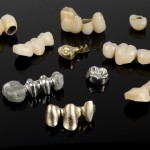
Replacement of missing and damaged teeth has traditionally been undertaken with fixed prosthodontic treatment (crowns, fixed dental prostheses (FDPs) using full metal or metal frameworks veneered with ceramic (metal-ceramic (MC). Recently metal-free systems have become available which should allow better reproduction of natural tooth colour, avoiding aesthetic shortcomings of MC restorations. However, the comparative clinical performance of these FDPs is unclear.
The aim of this review was to assess the effects of metal-free materials for prosthodontic restorations compared to metal-ceramic or other conventional all-metal materials.
Methods
Searches were conducted in the Cochrane Oral Health’s Trials Register, Cochrane Central Register of Controlled Trials (CENTRAL), Medline, Embase, the US National Institutes of Health Trials Registry (ClinicalTrials.gov) and the World Health Organization International Clinical Trials Registry Platform without restrictions on language or date of publication.
Randomised controlled trials (RCTs) comparing the clinical performance of metal-free fixed prosthodontic restorations and metal-ceramic (MC) or other conventional restorations with a minimum follow-up of 12 months were considered. RCTs in which the clinical performance of different kinds of metal-free systems were compared among themselves were also considered. The primary outcome was longevity of the restoration. Standard Cochrane methodological approaches were followed.
Results
- 9 RCTs involving 448 patients were included.
- 7 RCTs were considered to be at high risk of bias, 2 at unclear risk.
- Apart from 2 RCTs each trial addressed a different type of intervention.
- The available evidence was rated as very low quality.
- One trial compared metal-free single crowns (full contour zirconia) to cast gold single crowns (224 patients) finding insufficient evidence of a difference in failure rate after one year, but after five years there was some evidence of a benefit for the gold crowns. There was insufficient evidence of a difference for crown complications at either time of assessment.
- One trial compared 3-unit metal-free FDPs (lithium disilicate) to 3-unit metal-ceramic FDPs in 37 participants. finding insufficient evidence of a difference in bridge failure at one and six years, but some evidence of a benefit for the lithium disilicate group in terms of bridge complications at 6 years.
- One trial compared zirconia-ceramic FDPs to metal-ceramic FDPs in 34 participants but found insufficient evidence of a difference in bridge failures, bridge complications or patients’ aesthetic evaluation at any time of assessment up to 3 years.
- One trial compared metal-free cantilevered FDPs to MC cantilevered FDPs in 21 participants. There was insufficient evidence of a difference for any primary outcome: bridge failures (i.e. no failures in either treatment group), bridge complications, or patients’ aesthetic evaluation at any time of assessment up to 3 years.
- One trial compared metal-free implant-supported screw retained single crowns (zirconia veneered with feldspathic ceramic) to MC implant-supported screw-retained single crowns in 20 participants. There was insufficient evidence of a difference for any primary outcome at any time of assessment up to 2 years.
- Two trials compared metal-free implant abutments (zirconia) to metal implant abutments both supporting single crowns in 50 participants. There was insufficient evidence of a difference in abutment failure at one year.
- One trial compared metal-free implant-supported FDPs made of two different types of zirconia ceramic in 18 participants. There was insufficient evidence of a difference in failures at any time of assessment up to 10 years (i.e. no failures in either treatment group). There was some evidence of a benefit for the zirconia-toughened alumina group in terms of complications (chipping).
- One trial compared metal-free tooth-supported FDPs made with two different veneering techniques (pressed versus layered) in 40 participants. There was insufficient evidence of a difference for failures or complications at any time of assessment up to 3 years.
Conclusions
The authors concluded: –
There is insufficient evidence to support or refute the effectiveness of metal-free materials for fixed prosthodontic treatment over metal-ceramic or other type of standard restorations. The overall quality of existing evidence was very low, therefore great caution should be exercised when generalising the results of the included trials. Until more evidence becomes available clinicians should continue to base decisions on which material to use for fixed prosthodontic treatment on their own clinical experience, whilst taking into consideration the individual circumstances and preferences of their patients. There is urgent need of properly designed RCTs.
Comments
A wide range of metal-free systems for fixed prosthodontics have been proposed in the last 15 years. These have been based on ceramics or polymeric materials generally with the aim of providing most aesthetic restorations. This review highlights that while many systems are available there is very little high-quality evidence to guide choice of restorative material. More high quality, well conducted and reported RCTs involving larger number of patients are needed.
Links
Primary Paper
Poggio CE, Ercoli C, Rispoli L, Maiorana C, Esposito M. Metal-free materials for fixed prosthodontic restorations. Cochrane Database of Systematic Reviews 2017, Issue 12. Art. No.: CD009606. DOI: 10.1002/14651858.CD009606.pub2.
Other references

Cochrane Oral Heath Group blog on this review is now available http://bit.ly/2lNyiZ2